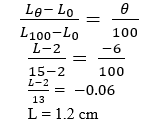Question 9
(a) Define each of the following terms used with simple machines:
(i)Pivot;
(ii) load;
(iii) efficiency.
(b) A truck of mass 1.2 3 kg is pulled from rest by a constant horizontal force of 25.2 N on a levelled road. If the maximum speed attainable in the process is 60km h-1.
(i) Work done by the force;
(ii) Distance travelled by the truck in reaching the maximum speed.
(c) State two differences between absolute zero temperature and ice point.
(d)An uncalibrated liquid-in-glass thermometer was used in determining a Celsius temperature. The readings are tabulated below.

Determine the value of L.
Observation
In question 9a, a significant number of candidates accurately defined the pivot, load, and efficiency.
Most candidates performed well in question 9b, with only a few struggling to convert km/hr to m/s.
In question 9c, the majority of candidates correctly distinguished between absolute zero temperature and ice point.
Finally, in question 9d, most candidates earned full marks by accurately calculating the value of L.
EXPECTED RESPONSES:
(a) Definition of terms
(i) Pivot: The point about which the turning effect occurs in the machine.
(ii) Load: The force overcome by an effort.
(iii) Efficiency: The ratio of work/energy output to the work/energy input
(expressed as a percentage)
A6
(b) Calculation of
(i) Work done = change in kinetic energy

(ii) distance travelled
Work done = Force (F) × displacement (d)
Fd = 1.67 × 10^5 J
25.2 d = 1.67 × 10^5 J
d = 6.63 × 10^3 m
B4
(c) Differences between absolute zero temperature and Ice point
Absolute zero |
Ice point |
The temperature at which all molecules are at rest |
The temperature at which vibratory molecular motion still occurs |
The lowest temperature on the absolute scale |
A temperature lower than 0 °C exists on the Celsius scale |
Not a fixed point on the absolute scale |
The lower fixed point on the celsius scale |
Has a value of 0 K/ -273.15 °C |
Has a value of 0 °C/ 273.15 °C |
C2
(d) Determination of L

